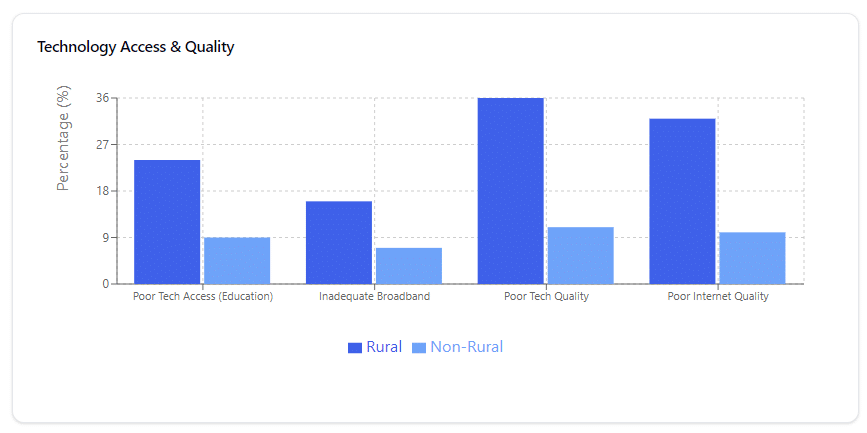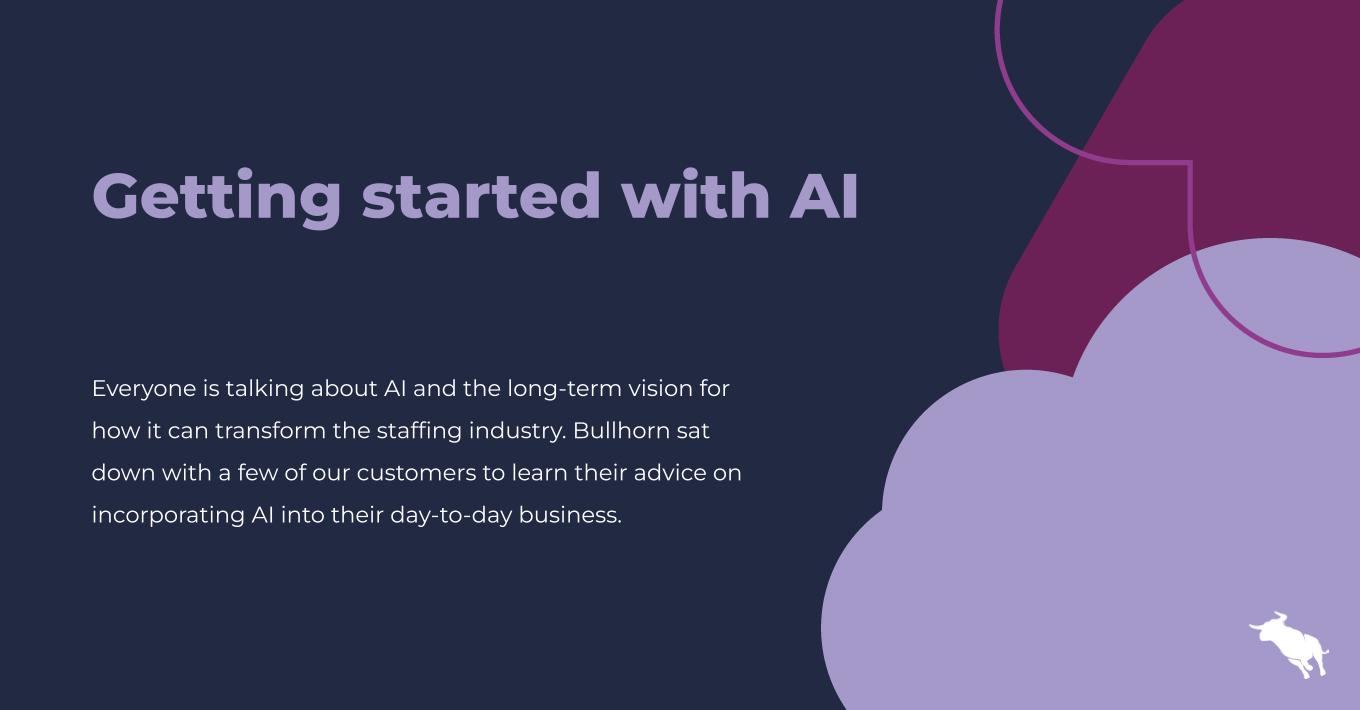Everyone is talking about generative AI and the long-term vision for how it can transform the staffing industry. But how should firms get started with this new technology? What can you do today?
Recently, Bullhorn sat down with a few of our customers at various stages of AI adoption:
- Nourus Ahmad, Recruitment Manager, Technology Service Professionals
- Neil Johnson, Operations Director, Apex Resource Management
- Nicole Shenberger, Business Operations Specialist, Johnson Service Group
- Matthew Finlay, Director, Calibre Search
Read on to learn the practical advice they shared on incorporating AI into their day-to-day business.
What are you actually using AI for today?
Nourus Ahmad, Technology Service Professionals: We are using ChatGPT to see how it can improve job descriptions.
Neil Johnson, Apex Resource Management: [We’re] using ChatGPT to take a job description and put it into layman’s terms and writing job adverts on the back of it. We specialize in automotive, manufacturing and engineering…Quite often when we receive an engineering job specification from a client, it’s written in engineer’s jargon and every manufacturer seems to have their own way of writing job descriptions. We use ChatGPT to help us debunk it.
Nicole Shenberger, Johnson Service Group: We are using ChatGPT to improve content and help out with generating basic recruiting functions. We are still learning and researching how else it can be used throughout the company.
Matthew Finlay, Calibre Search: We’ve used it to analyse data sets by feeding it some numbers from excel and asking it to summarise the findings. This has worked really well.
Shenberger: But you have to be cautious of how you are using this AI-generated content. You have to review it first, make edits, and make it your own.
What does your organization need to do to really take advantage of AI’s potential?
Finlay: For use it was the data cleanliness journey. It wasn’t the worst database in the world, but it was a bit unkempt. And when the GDPR rules started coming in, we had a bit more focus on [the data cleanliness].
Johnson: We want to get the data right in the database to ensure that the data is as accurate and easy to access as possible. This will still require consultant training to highlight to them the benefits of this..
Finlay: Just in the last 6-12 months I have been looking more [at] how much of our database engaged, how many people have clicked, how many people [we] got to connect with. I reckon within 12 months, maybe less, I’d probably be in a position where we’re like, yeah…[the] cleanliness is good.
Ahmad: The privacy aspect of it is very important for us, hence our being interested in [a solution] associated with Bullhorn, something that we’re already using. And if it’s something associated and linked and integrated within our application tracking system, that’s even better.
What potential roadblocks do you think stand in the way of moving to the next step?
Shenberger: I think it’s going to take a lot of training and educating. The idea of AI is to make your job easier, not harder. It seems to be people are either very excited about AI or very cautious of the tool. Staffing is a very relationship-driven business, so you have to be strategic with the technology.
Johnson: So initially, when we introduced it, we got early adopters i.e. those who were keen to be part of the team to investigate more about AI and how it could be used within the business. Additionally, we had a couple of people who wanted to learn more about it…so we held a session around ChatGPT to explain its capabilities, and what it could offer them. I think once everyone understood what it could do for them, to reduce that amount of manual effort they were having to utilise so they could maximise the amount of time [they can spend]…doing great value-add activities, that convinced them that AI is a tool to be embraced and not feared.
Finlay: The stuff I want to do before is retraining, to get them up to speed. And another one of the key things is that we would link that with automation.
Realistically, what are the best near-term use cases, the short-term next steps for AI?
Finlay: I imagine AI could help with the most time-consuming tasks like communication. I wouldn’t be comfortable with communication that was just put out by AI; you’d always feel like you need somebody to manage it. But it could magnify the amount of output that you could possibly have by one person.
Shenberger: Use cases seem to center around speed to candidates — You can use the technology to create more complex boolean searches in seconds. You can use it to help create message templates faster, you can just copy, paste, and then edit the work to make it your own.
Johnson: Some sort of market intelligence as well is quite useful…You’ll have people using it to hit the next level of what they can do to save time. And using chatbots for some sort of pre-qualification type questions.
Finlay: Searching for CVs. That seems to be the most time-consuming thing.
Johnson: I could see it theoretically working as follows: a job description is received from a client. We plug that description into an AI tool that creates our job advert for us. It then creates the Boolean search that we need as well. It goes away, populates what it needs to within the job boards or Linkedin, does the search, and pulls back the most suitable candidates based on that criteria. And then the next stage will be to do the initial outreach to suitable candidates.
What final thoughts would you like to share?
Johnson: AI is going to increase the volume of work we are able to cope with as we’re not having to deal with that manual leg work in the background. It’s hopefully been done for [the recruiters], or 80/20 done for them, so they can really focus on the placement-making activities and process.
Shenberger: Staffing is such a personal industry; we’re talking and developing relationships with candidates and with clients. I would hate to have people lose that side of things. But, I think if AI is used right, in conjunction with the relationships that are being built, it can definitely be pretty powerful. I’m excited to see what is to come.









